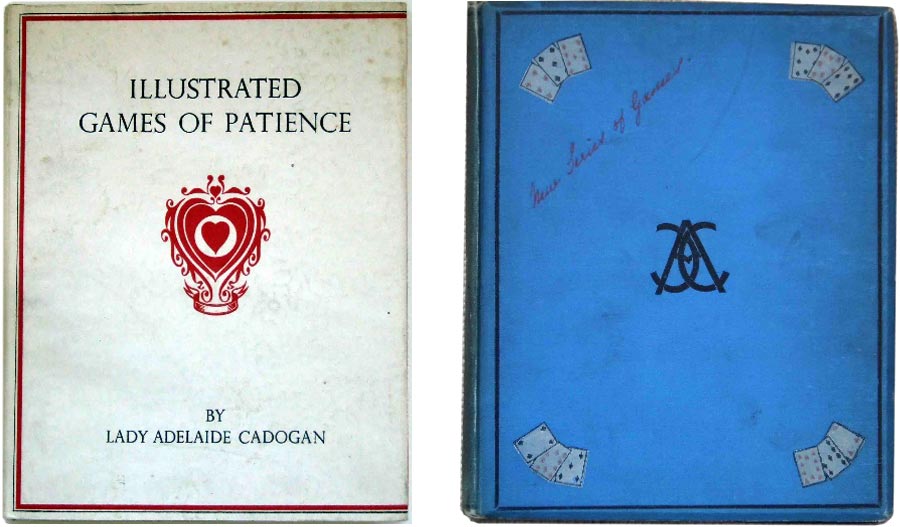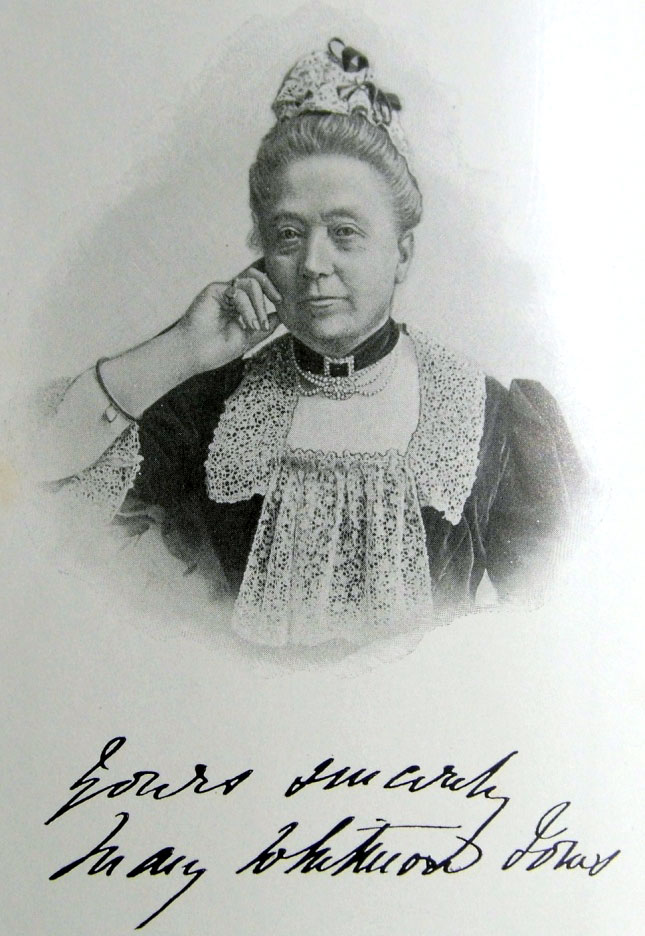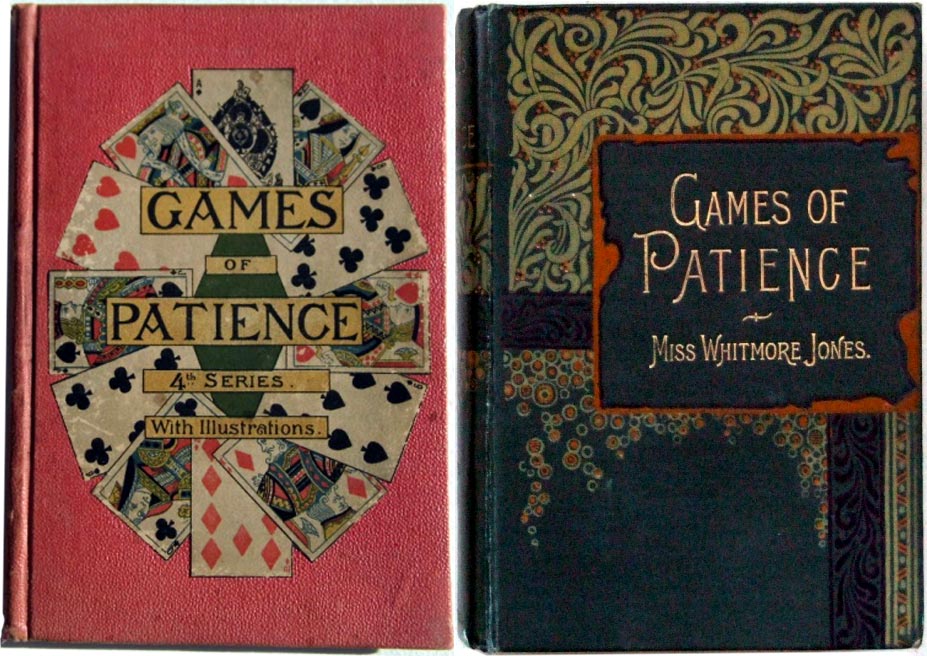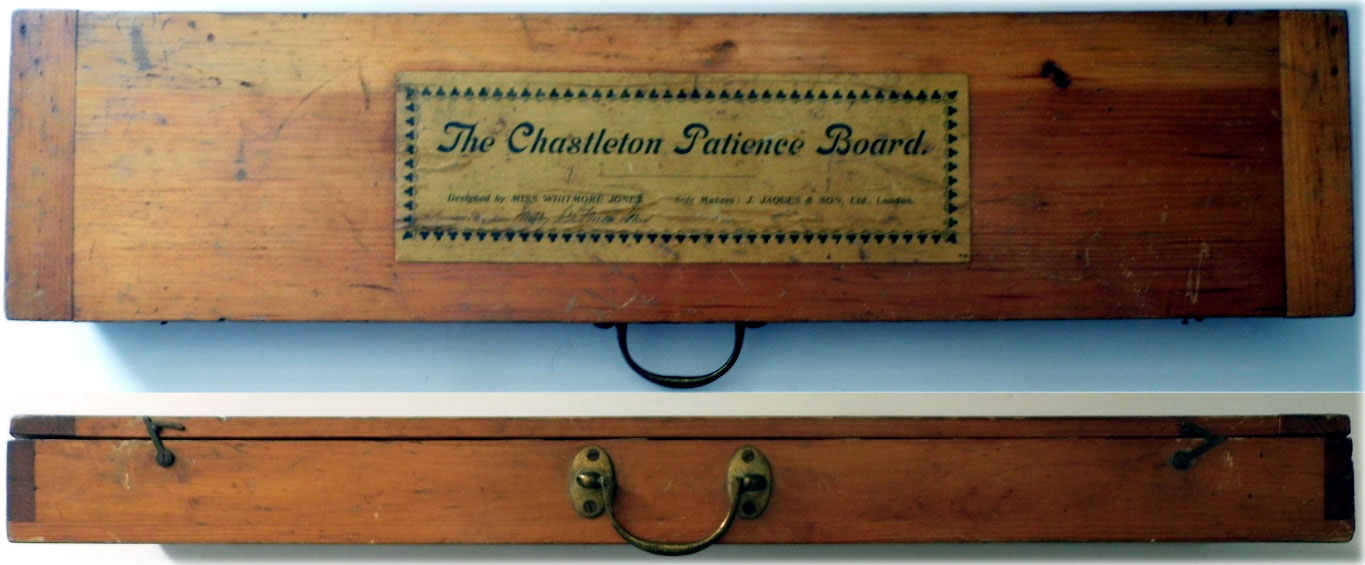Mary Whitmore Jones and her Chastleton Patience Board
Mary Whitmore Jones and her Chastleton Patience Board by Tony Hall.
“Doctors say that it is most valuable, for that any unexciting game
soothes the brain, and is the best remedy against insomnia.”
Games of patience using playing cards have probably been around as long as playing cards themselves. Certainly, from the middle of the 19th century, there was no shortage of books inviting players to extend their repertoire of games from the standard form to increasingly more complex varieties drawn from across the world. I have a small collection of around 20 such books dating from 1870 to 1920.
There are a number of notable contributors to popularising the game of Patience in the English language in the 19th Century. According to Frederic Jessel’s invaluable bibliography of card games [1], the first book of patience published in England was by Madame de Chatelain (translation of a collection by Madame de F---- ) whose second edition was published in 1859; the date of first edition is unknown.
Capitalising on the growing popularity of Patience, Lady Adelaide Cadogan, daughter of the 1st Marquis of Anglesey, published the first edition of her collection, the Illustrated Games of Patience in 1874 and her second series in 1887 [2].

Above: Lady Adelaide Cadogan published in 1874 and 1887.
Almost inevitably, Henry Jones, as the most prolific and respected author on card games of his era, writing under his nom-de-plume “Cavendish”, produced his book of Patience Games. This large format book (26¾ x 21¾ cm) is possibly the most eye-catching and beautifully produced on the subject ever published [3]. Some of the interior graphics and art work are a colourful delight and it clearly was not a cheap production, underlining, perhaps, the popularity of patience games themselves as well as the financial position of many patience enthusiasts.

Above: Patience Games by “Cavendish”, Thos. De La Rue, London, 1890.
In the late 1880s, the “Cavendish” contribution was followed by Professor Hoffmann [4] : “The Illustrated Book of Patience Games” [5]. One of my copies (illustrated below) is a second edition, published in 1900.

Above: The Illustrated Book of Patience Games, translated and illustrated by Professor Hoffmann, George Routledge & Sons, 1900.
If you look carefully at the frontispiece, a bracketed comment has been over-drawn by Indian ink – possibly by the retailer, or by one of its original owners. In one of my later editions (9th edition, 1920) I can see that the obscured line reads: “(From the German)”. This book was being read and shared during difficult times in the years after publication!
But all of these authors pale into insignificance when compared with the Patience guru of the age – the incomparable Miss Mary Whitmore Jones.

Above: Mary Whitmore Jones (c.1823-1915) [6].
It was initially difficult to ascertain when Miss Whitmore Jones’s first book appeared – libraries and booksellers guess, because few of the many L. Upcott Gill publications of her work are dated, and some of the guesses vary widely. She produced at least eight substantial books on the subject, with many of them being reprinted as collections. Collecting Whitmore Jones books is like collecting Bob Dylan albums (which I also do!). In addition to the individual items there are a variety of “Greatest Hits” collections. Finally, thanks to Frederic Jessel’s 1905 Bibliography of Playing Cards and Gaming all is clear! Her first book, Games of Patience for one or more players was published in 1888, and was reprinted in 1890, the same year as publication of her second series. These were quickly followed by three more – Third Series in 1892, Fourth Series in 1898 and Fifth Series in 1900. The first five series looked like this Series 4 example (left-hand image below) – 18½ x 12½ cm.
The first five series were then reprinted in a bumper volume of 460 pages (19 x 13 ¾ x 4 cm) containing no less than 172 games! (right-hand image below).

Above Left: Series 4 example – 18½ x 12½ cm., 1898. Right: The first five series were then reprinted in a bumper volume of 460 pages (19 x 13 ¾ x 4 cm) containing no less than 172 games!
Series one and two were reproduced as a single volume in 1905, and other variants followed.
Not content with this output, between 1905 and 1911 she published at least two more substantial volumes (22½ x 15¼ x 2 ½ cm) under the heading “New Games of Patience” [7].

Above Left: New Games of Patience, M. Whitmore Jones, L. Upcott Gill, 1911. Right: The ABC of Patience, Mary Whitmore Jones, Henry J. Drane, undated. Not to scale.
She also contributed a “Patience” volume (14½ x 11 cm) to the splendid A.B.C Series [8]. These “pocket-sized” volumes covered the basics in everything from Carpentry and Cage Birds to Palmistry and Phrenology; from Cooking for Invalids to Motoring.
The most extraordinary thing about Miss Whitmore Jones is that she had any time to play, research and write about Patience or any other activities to be undertaken in “spare time”; I am not sure she had any. She was the author of several novels, half a dozen biographies and books on historical events as varied as the Chastleton House and the Gunpowder Plot, and the Siege of Derry.
In the introduction to her first edition of Games of Patience, she explains the value and variety of uses of patience as a pastime:
“Let no one despise the games of Patience. Many are apt to do so, and to look down on it as altogether puerile, because it is humble among games; … Nevertheless, it has its uses, and there are many overworked brains, lonely hearts, and pain-racked nerves, that can testify to them. We know of ladies living alone who have sat through their solitary evenings reading, writing, or working, till their brains are dazed and fingers sore; and they have found it an immense relief to put their books and work aside, get out their cards and solace themselves with a game of patience before going to bed. We know of professional men who play it regularly every evening; it makes a break in their thoughts, and keeps them from dwelling at night on the business that has been absorbing them all day. Doctors say that it is most valuable, for that any unexciting game soothes the brain, and is the best remedy against insomnia. We know of invalids, condemned to lie on a dreary couch the live-long day, who look forward to their evening Patience as the most enjoyable time of their sad existence.”[9]
It was this last concern which prompted Miss Whitmore Jones to invent the Chastleton Patience Board [10] sometime between 1875 and 1898. Eventually she made an exclusive agreement with Britain’s premier games making company, J. Jaques & Son Ltd, to produce copies of her board. This was agreed on the understanding that she would personally sign every individual copy sold.
My own copy, still in remarkable condition given its age and use, also carries the good lady’s personal signature, albeit somewhat faded – Mary Whitmore Jones.

Above: Mary Whitmore Jones’s signature on the box.
The box itself is a relatively complex design and it functions exactly as she claims, working today as well as it did when first purchased 120 years or so ago.

Above: How to Play patience; A Short Treatise on the Game and Directions for using the Chastleton Patience Board, J.Jaques & Son Ltd.
In her introduction to How to Play Patience [11] which accompanied the Chastleton board, she writes:
“For a patient recovering from illness (patience) is invaluable, being sufficiently intricate to amuse without exciting the languid brain of the convalescent; and if it causes pain and weariness to be forgotten, even for only half-an-hour at a time, it is giving nature valuable aid towards recovery. One difficulty in the way of doing this hitherto has been the impossibility of laying out the cards except on a flat surface, which could not bring them within the view of a man, say, lying on his back with a broken leg. To obviate this the Chastleton Patience Board was invented. It can be placed at any angle, and the cards being secured in the straps, are kept quite stationary, and are at the same time easily manipulated, even with one hand. The board folds up when not in use, and takes very little room, which is another merit in the sick chamber.”
She goes on to advocate its use for tourists where “it will be tied up with his rugs and umbrella”. (I love this vision of tourist behaviour at, or just after, the turn of the last century.) It can be used when “waiting an hour or so at a small railway station”, in “seaside lodgings” when its raining; “during a dull, uninteresting railway journey” or on an ocean voyage, “let the ship pitch and toss as much as it will”. Clearly today’s mobile phone covers all of these eventualities and takes up even less room.
But for its time and function, the Chastleton Board is a rather clever design, and beautifully realised by Jaques & Son Ltd (22½ x 15¼ x 2 ½ cm). It comprises a slim, sloping carrying case with two brass catches and a handle. My version (pictured below) is in pine but, unless a number of auctioneers are mistaken, it was also produced in mahogany.

Above: the Chastleton Patience Board produced by John Jaques & Son Ltd.
It opens to reveal 12 rows of material (which she terms “the slips”) periodically pinned to ensure that miniature cards inserted as required are held firmly in place. At the base are 16 “stalls” built to accommodate “pigmy” [12] or “bijou” patience cards. She recommends the former as “they are the best to play with and take up less room”.

Above: the Chastleton Patience Board produced by John Jaques & Son Ltd. 61 cm x 14 cm x 6 cm.
Metal staples are inserted at the head of each stall to prevent cards from falling out when the box is closed. It is shaped and hinged so as to be equally useable in a prone or upright position and measures 61 cm x 14 cm x 6 cm.

Above: details from the Chastleton Patience Board produced by John Jaques & Son Ltd.
Miss Whitmore Jones’ instruction booklet for the Board contains a brief description of 10 patience games, eight of which were previously published in her various collections [13]. Five are one-pack games: Sir Tommy (claimed to be the first ever game of this kind), Demon, Thumb & Pouch, Storming the Height and Somerset. Five are two pack games: Maria, Backbone, Miss Milligan (claimed to be Queen Victoria’s favourite), Royal Procession and Emperor.
Mary Whitmore Jones inherited the Chastleton country house and estate in 1874 at the age of 51 when her brother Willie died. She was unmarried and did not have any children. Within a few years she passed the management of the estate to her nephew Thomas Whitmore Harris who later changed his name to Whitmore Jones. Mary moved from the great house to the rectory on the estate and by 1901 lived elsewhere in the village. She died in 1915.
The house itself, now managed by the National Trust , was built between 1607 and 1612. The Whitmore Jones family did not have great wealth and one can only presume that Miss Whitmore Jones published her collections and assorted books not just for fun but as a way of generating a personal income and contributing financially to the up-keep of this great pile before, eventually, it became too great a burden.
A redoubtable woman indeed.
Tony Hall, April 2020.
References cited in text
1. A Bibliography of Works in English on Playing cards and Gaming, Frederic Jessel, Longmans, Green & Co., 1905.
2. Illustrated Games of Patience, Lady Adelaide Cadogan, Sampson Low, Marston, Searle & Rivington, 1887.
3. Patience Games with Examples played through, “Cavendish”, Thos. De La Rue, London, 1890.
4. Angelo John Lewis.
5. The Illustrated Book of Patience Games, Translated and Illustrated by Professor Hoffmann, George Routledge & Sons, 1900.
6. Reproduced from Games of Patience for one or more players, M. Whitmore Jones, First series, L. Upcott Gill, 1889 x 13 ¾ x 4 cm).
7. New games of Patience, M. Whitmore Jones, L. Upcott Gill, 1911.
8. The ABC of Patience, Mary Whitmore Jones, Henry J. Drane, undated.
9. Op. cit. 1888.
10. Named after the country house she inherited in 1874.
11. How to Play patience; A Short Treatise on the Game and Directions for using the Chastleton Patience Board, J.Jaques & Son Ltd.
12. The term used by De La Rue for their premier range of miniature cards.
13. I have not found Storming the Height and Royal Procession in any of her other works in my collection.

By Tony Hall
Member since January 30, 2015
I started my interest in card games about 70 years ago, playing cribbage with my grandfather. Collecting card game materials started 50 years or so later, when time permitted. One cribbage board was a memory; two became the start of a collection currently exceeding 150!
Once interest in the social history of card games was sparked, I bought a wooden whist marker from the 1880s which was ingenious in design and unbelievably tactile. One lead to two and there was no stopping.
What happened thereafter is reflected in my articles and downloads on this site, for which I will be eternally grateful.
Related Articles

Quaterne
A Victorian quartet-style children’s card game by Goodall & Son.

The Molassine Company and its link to Whist and Bridge
A savvy marketing strategy blending Victorian decorative design with Edwardian practicality.

Waddington’s faux books
Waddington’s faux book set containing four packs of playing cards and bridge markers.

Patience by Joseph Glanz
A refined and distinctly European Patience pack by Joseph Glanz from Austria.

Double Dummy Bridge
In the early 20th century several firms began to promote whist or bridge as a game for two.

Ogdens Beauties & Military cigarette cards
Cigarette cards featuring beauties and military uniforms with playing-card insets.

Boddingtons Bitter playing cards
Cool-looking courts advertising Boddingtons Bitter, originally brewed in Manchester.

OXO Faces of the Millennium Dinner
Twentieth-century personalities promoting a millennium dinner at the Oxo Tower in London.

Kids Fun Box playing cards
Colourful cards for children with four non-standard suits connected with the natural world.

Tangle Foot Ale
Badger Brewery Tangle Foot strong ale advertising pack.

Scientific Whist
“Scientific Whist” : standard cards with instructions for play on the faces by Chas Goodall & Son, 1...

Agent Provocateur
Branded lingerie collection in a pack of pin-up playing cards.

Nimbus playing cards
Mike Steer’s weather-themed pack with suits in four colours and backs for cardistry.

Danao Tiāngōng Puke
Children’s playing cards based on the 1961 Chinese animated feature film 大闹天宫 (Havoc in Heaven).

Agatha Christie and Playing Cards revisited
Agatha Christie uses card-play as a primary focus of a story, and as a way of creating plots and mot...

The Decadent Deck
Studies in the eroticism of the female body by Inge Clayton.
Most Popular
Our top articles from the past 28 days

